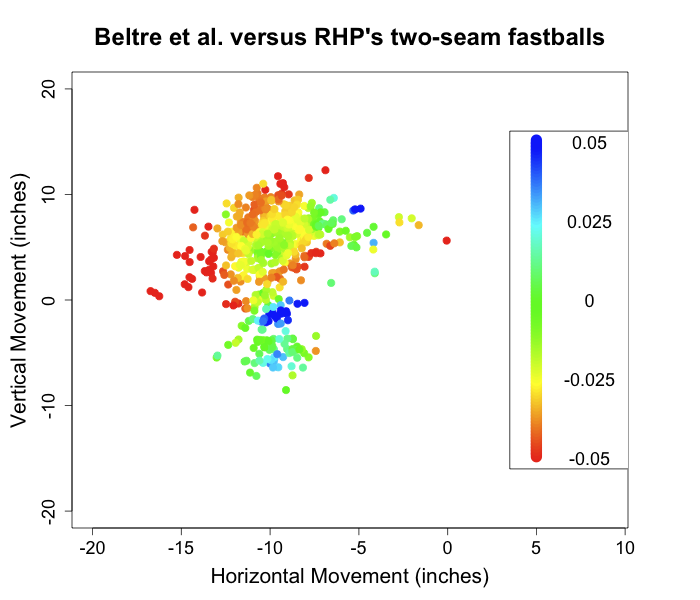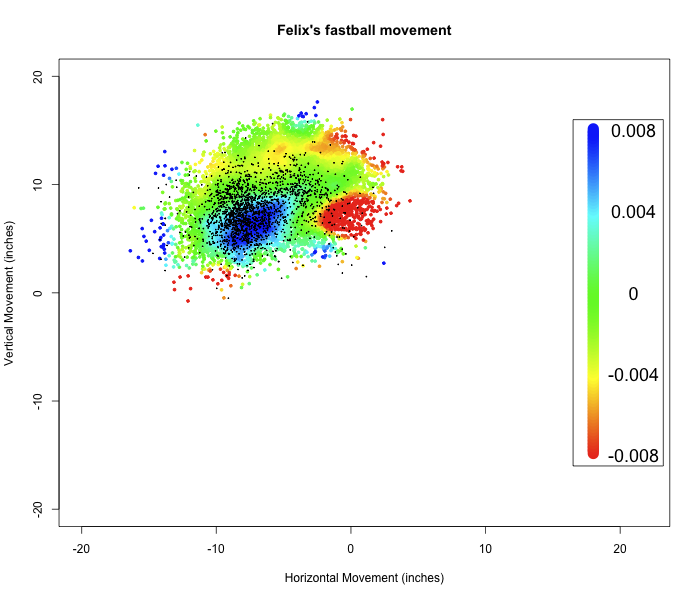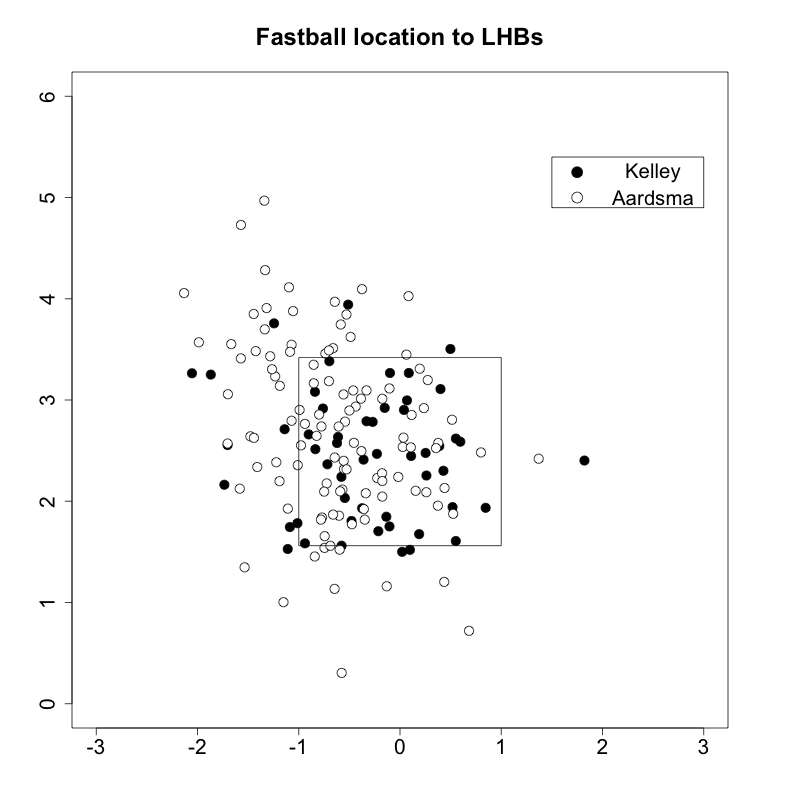The Problem With The Right-Handed Line-Up
As you’ve heard me talk about incessantly since the season started, the Mariners line-up is too right-handed. With Wladimir Balentien replacing Endy Chavez as the regular left fielder, the M’s normal line-up now includes six right handed bats (Beltre, Lopez, Betancourt, Johjima/Johnson, Gutierrez, and Balentien) and three left-handed bats (Ichiro, Griffey, and Branyan). Exacerbating the problem is that the six RH bats are very similar types of hitters. Gutierrez is the only one who won’t actively get himself out chasing pitches out of the strike zone, and all of them prefer to pull the ball when hitting for power. There are no Edgar Martinez’s in that group – it’s a bunch of aggressive bats who can hit something straight but struggle with pitches that move.
Not surprisingly, the M’s offense goes to sleep pretty much any time the opposing team throws a right-handed starter. The quality level hasn’t mattered – whether it was Jered Weaver, Josh Beckett, Scott Feldman, Bartolo Colon, Vicente Padilla, Shane Loux, Trevor Cahill, Nick Blackburn.. they all look like aces against the M’s.
But why?
To answer that question, I’ve turned to Dave Allen, one of the newest and best Pitch F/x analysts out there today. He’s doing yeoman’s work over at The Baseball Analysts, helping take Pitch F/x analysis to another level. I asked Dave to use the Pitch F/x data to help reveal some of the issues that the M’s line-up currently has against RHPs. We also get into the pitching of Felix and Shawn Kelley. The transcript of our conversation is below.
Me:
You recently wrote a really interesting piece about fastball movement and the different run value zones based on handedness of the batter. For those who missed it, the conclusion was basically that two-seam fastballs are extremely effective against same handed batters and not effective at all against opposite handed hitters. The Mariners have a roster that requires them to start at least five right-handed batters (sometimes six or seven) every single game, even when the opposing team is throwing a right-handed pitcher who features a two-seam fastball. Can you explain for our readers just how bad a match-up right-handed bats are against two-seam fastball pitchers, and why the pitch is so much less effective against left-handed bats?
Dave Allen:
Here is the image from that post. It shows the average (over pitch speed and locations) run value of a two-seam fastball from a RHP to RHB versus LHB based on the pitch’s movement. Negative horizontal movement is in to RHBs and positive is in to LHBs.
The difference is huge. Against RHBs the average run value of a two-seam fastball is -0.01 and against LHB it is 0.005. Although these numbers seem small they add up quickly over the course of a many two-seam fastballs in a game. This is the largest platoon split of any pitch, twice as large as the slider platoon split and three time larger than the four-seam fastball platoon split.
Here is a breakdown of how RHBs and LHBs perform against RHP’s two-seam fastballs by a number of metrics that are a little bit more intuitive than run value:
+-----------------+--------+--------+ | | RHB | LHB | +-----------------+--------+--------+ | Swinging Strike | 0.058 | 0.044 | | O-Swing Rate | 0.288 | 0.237 | | GB per BIP | 0.688 | 0.626 | | BABIP | 0.280 | 0.331 | +-----------------+--------+--------+
This analysis includes two-seam fastballs and sinkers, which are hard to differentiate with the pitchf/x data. These fastballs are typically low in the zone, rise less than other fastballs (so the appear to ‘sink’ to batters) and tail in to same-handed batters 10 inches on average, more than any other pitch type. I am not sure why they show such a large platoon split, but I think the large horizontal movement probably plays a big role.
No matter the reason, as you have said before righty dominated lineups make mediocre two-seam throwing pitchers look amazing.
Me:
So, basically, what you’re saying is that there’s no reason to expect the Mariners offense to do significantly better against right-handed pitching, especially guys who feature two seam fastballs, while they’re running out a lineup that includes Lopez, Betancourt, Johjima, Beltre, and Gutierrez? There’s really very little hope for those guys to do much against that kind of pitcher on a regular basis? The only way to fix this problem is to be able to start a left-handed bat in place of one or two of these guys?
Dave Allen:
This is bad news. As a group these guys hit RHP’s two-seam fastballs to the tune of -0.021 runs per pitch. Twice as bad as the average RHB. Here is their composite run value by pitch movement graph for two-seam fastballs from RHPs.

It seems these guys don’t have as much problem with heavy sinking fastballs (the bottom group of pitches with a negative vertical movement come from submarine-style delivery pitchers), but rather with fastballs that tail in to them heavily.
Say you could replace one of these guys with a league average lefty who hits two-seam fastballs for a run value of 0.005 per pitch. That is a swing of 0.025 runs per two-seamer. In a game against a two-seam throwing righty let’s say this putative replacement gets up 4 times and sees about 2 two-seamers per at-bat. During just the one game that is a swing of about 0.2 runs. This is the type of small shift that adds up quickly over if a team faces lots of two-seam throwing righties.
Me:
.2 runs per right-handed batter per game? That’s nutty. If the M’s swapped out two of these right-handed bats for just league average lefty’s, they could add nearly half a run per game to their vs RHP offense? That’s huge. Huge. Hopefully they’re looking at similar data and make the necessary moves.
Let’s talk about something else, though staying in the same realm of discussion. Felix Hernandez is obviously a very talented kid. His stuff is among the best in baseball, and he’s shown glimpses of actual ability to command his fastball this year. But, as is the case every year, he’s really struggled against line-ups that have good left-handed bats, recently giving up home runs to Chris Davis, Joe Mauer, and Justin Morneau. Can you give us a glimpse of why he has such a large platoon split, despite throwing four different pitches?
Dave Allen:
As you and your readers are aware Hernandez has an enorourms platoon split. Over his career righties have an OPS of .627 against him, that is about the level of worst regular in baseball last year. On the other hand lefties hit him for an OPS of .790, that is the level of BJ Upton, Adrian Beltre or Alexei Ramirez last year. A pitcher with four quality pitches should not have such an exreme platoon split. Here are the run value per pitch broken up by pitch type and handedness of the batter for Hernandez and for the average RHP. In parathenses is the proportion of at-bats the pitch is thrown.
+------------+-------------------------------+-------------------------------+ | | Felix Hernandez | Average RHP | +------------+-------------------------------+-------------------------------+ | | RHB | LHB | RHB | LHB | +------------+---------------+---------------+---------------+---------------+ | Fastballs | -0.013 (0.70) | 0.010 (0.71) | -0.003 (0.61) | 0.003 (0.62) | | Changeups | -0.021 (0.02) | -0.009 (0.07) | 0.001 (0.07) | 0.001 (0.16) | | Sliders | -0.006 (0.20) | 0.008 (0.11) | -0.006 (0.23) | 0.001 (0.12) | | Curves | 0.001 (0.08) | 0.005 (0.11) | -0.001 (0.10) | -0.001 (0.10) | +------------+---------------+---------------+---------------+---------------+
His fastball to RHBs is just amazing. He throws it alot, but it is still four times better than the average RHP’s. Against LHBs his fastball is bad, three times worse than the average RHP’s fastball to LHBs. That is an amazing platoon split for a fastball (Safeco probably plays a small part in this split), but he throws the fastball just as much to LHBs as he does to RHBs.
In black below I indicate the movement of his fastballs. I plotted that over the run value for all fastballs from RHPs to LHBs based on movement.

Felix’s fastball has exactly the type of movement that is crushed by lefties. He really should not be throwing it so often to them, and he doesn’t need to because he has other viable pitches. His change up is amazing versus lefties, but the throws it less than half as often as the average RHP. If he threw it more often it might lose some of its effectiveness as batters get more used to it. Still, it seems, he should be throwing change-ups at least at league average rate against lefties, if not more, and these pitches should come at the expense of his fastballs.
Me:
We’ve also noticed that Felix’s change-up has steadily been gaining velocity over the last couple of years. He used to throw it at 85, but now it’s regularly 88-89, giving it very little separation in speed from his fastball. Can you talk about how a power change-up effects the movement he’s getting and how this will effect his development going forward?
Dave Allen:
It does look like Hernedez’s changeup has gained speed over the years. The pitchf/x system was phased into parks during 2007 so the data is spotty for the year, but here are histograms of his changeup velocity from 2007 to 2009.

The changeups are definitely getting faster and they might be getting less variable in speed as well. Generally as the speed of RHP’s changeup increases it has more rise and more tail into RHBs. It looks like Hernadez’s show the opposite pattern. So far this year his changeups have had less rise and less tail, but the change is subtle.

At this point it has not influenced the outcome. In 2007/2008 his changeup was worth -0.009 runs per pitch to lefties and so far this year has been worth the same. I don’t really know what to say about his change-up other than it remains a very effective pitch against lefties even as it increases in speed, gets less separation from his fastball and is the smallest bit flatter.
Me:
Let’s finish with some good news. Shawn Kelley was the biggest reason for optimism the M’s got in the first month of the season, as the rookie dominated by pounding the strike zone with his fastball/slider combination. Usually, guys with just those two pitches don’t do very well against opposite handed batters, but Kelley was brilliant against lefties, striking out six of the 19 he faced without walking anyone. Can you give us some insight into why his stuff worked against LHBs, when a guy like Mark Lowe, who has similar velocities to the same two pitches, can’t get lefties out to save his life?
Dave Allen
Aardsma and Kelley both throw a four-seam fastball and a slider. These are pitches with sizable platoon splits (although not as large as the two-seam fastball), and neither pitcher throws a changeups or curves that are effective pitches against lefties. Both throw predominately their fastballs to lefties, although Kelley mixes in his slider a little bit more often. First we will check in on fastball movement, again I show the movement of their fastballs over run value of the average RHPs four-seam fastball to lefties:

Aardsma’s fourseam fastball has a little bit more rise than Kelley’s. Based only on fastball movement we would exect Aardsma to have more success against lefties. Clearly there is somethign else going on:
+-----------------+-----------------+-----------------+ | | Kelley | Aardsma | +-----------------+--------+--------+--------+--------+ | | RHB | LHB | RHB | LHB | +-----------------+--------+--------+--------+--------+ | In Zone Percent | 0.657 | 0.662 | 0.519 | 0.491 | | O-Swing Rate | 0.257 | 0.417 | 0.297 | 0.268 | | Swinging Strike | 0.058 | 0.052 | 0.100 | 0.082 | +-----------------+--------+--------+--------+--------+
Kelley is able to get the same fraction and his pitches in the zone against LHBs and RHBs, while Aardmsa already low zone% is even worse against LHBs. Somehow Kelley also induces more swings at pitches outside the zone (O-swing rate) against LHBs than RHBs. I am not convicnced this is sustainable, but is the big reason for his success so far this season. Here are the locations of their pitches:

Kelley doesn’t miss by much, which is probably why he has such a high O-swing rate. If he can keep hitting his spots on the outside edge of the zone, even with some O-swing regression he should be effective against LHBs going forward. Aardsma, like Kelley, pitches mostly away to LHBs, but is outside the zone too frequently and when he misses he misses by too much to be effective.
Me:
This is great, great stuff Dave. Thanks so much for being willing to spend some time on this. We look forward to reading more of your stuff over at The Baseball Analysts for however long you last there before you become the next guy hired from the web into Major League Baseball.
Comments
56 Responses to “The Problem With The Right-Handed Line-Up”
Leave a Reply
You must be logged in to post a comment.


Here’s a crazy question. Could Beltre possibly be a plus defensive 2b? how bad is Branyan at 3b? Since we have lefty hitting 1b/dh at AAA could this be an option. Beltre would actually be a good hitting 2b and maybe he wouldn’t feel the need to try so hard.
So in the Felix fastball to lefties location chart.
What does this mean? Are these the fastball locations for every fastball to both righties and lefties that Felix has thrown this year?
Also, if Felix’s fastball stayed mainly in the happy red area instead of the sad blue area, would that make his fastball dominating to both lefties and righties, or one of the two? Or are the red areas red because they’re out of the strike zone and you hitters can’t reach them?
Outstanding write up and analysis. Thanks so much!
This is exactly why I read this blog, every time I learn something new. This post shows how hardcore you guys are, I just hope your expertise is one day rewarded.
Sorry I was not 100% clear. The black dots show the movement of Felix’s fastballs. The heat map shows the run value based on movement of ALL RHPs fastballs to LHBs. Just because Felix’s fastballs are in the blue region doesn’t necessarily mean his will be unsuccessful. Since I am averaging over all RHPs it does not take into account speed or location. All it shows is that based solely on movement you would expect him to be unsuccessful versus LHBs.
That figure is not the location of the ball but its movement. The movement of a pitch is the difference (broken up into vertical and horizontal components) from where the ball ends up and where you would expect a spinless ball to end up. So it measures how much rise or sink and break in or out a pitch has.
And, less than a year later, the votes are in: eponymous coward wins.
Also, Felix in 2009 didn’t throw appreciably more changeups (13.6% in ’09; 13.3% in ’08) or significantly fewer fastballs (63.2% in ’09; 65.9% in ’08)… he just threw better ones. And was rewarded. Don’t spend the $78M all in one place, kid.